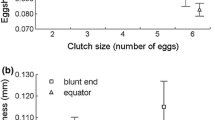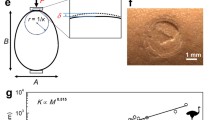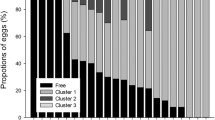Abstract
A few avian species breed at altitudes up to 6500 m. Embryos in eggs laid at high altitudes are confronted with the problem that gases diffuse more rapidly at low barometric pressure than at sea level. Data on birds breeding up to 4500 m indicate that modifications in eggshell structure and embryonic physiology foster successful development in these groups. At moderate altitudes (up to 3600 m), shell conductance to gases (corrected to 760 torr) is decreased in approximate proportion to the reduction in barometric pressure, thus offsetting the increased tendency of gases to diffuse. At altitudes above 4000 m, the conductance is increased above levels at moderate altitudes, thus fostering improvement in oxygen availability, while increasing rates of water and CO2 losses. Above 4000 m, embryonic physiological properties become increasingly important for coping with hypoxic, hypocapnic, and dehydrated conditions inside the shell. Nothing is known about characteristics of eggshells and embryos in eggs laid between 4500 and 6500 m. Despite years of artificial selection, domestic fowl do not breed successfully much above 3000 m. Embryos of domestic fowl appear highly sensitive to the effects of hypoxia.
Similar content being viewed by others
References
Aggazzotti A 1913 Influenza dell’aria rarefatta sull’ontogenesi. Noata 1. La perspirazione delle ova di gallina durante lo svilluppo in alta montagna;Wilhelm Roux Arch Entwicklungsmech. Org. 36 633–648
Ar A, Paganelli A. V, Reeves R B, Greene D B and Rahn H 1974 The avian egg: water vapour conductance, shell thickness and functional pore area;Condor 76 153–158
Ar A and Rahn H 1978 Interdependence of gas conductance, incubation length, and weight of the avian egg;Respiratory function in birds, adult and embryonic (ed.) J Piiper (Berlin: Springer-Verlag) pp 227–236
Ar A and Rahn H 1980 Water in the avian egg: overall budget of incubation;Am. Zool. 20 449–459
Baumann R, Padeken S, Haller E—A and Brilmayer T 1983 Effects of hypoxia on oxygen affinity, haemoglobin pattern, and blood volume of early chicken embryos;Am. J. Physiol 244 (Regulatory Integrative Comp. Physiol. 13) R733-R74I
Burton R R and Smith A H 1969 Induction of cardiac hypertrophy and polycythemia in the developing chick at high altitude;Fed. Proc. 28 1170–1177
Carey C 1983 Structure and function of avian eggs; inCurrent Ornithology (ed.) R F Johnston (New York: Plenum) Vol 1, pp 69–103
Carey C 1986 Tolerance of variation in eggshell conductance, water loss, and water content by Red-winged Blackbird embryos;Physiol. Zool,59 109–122
Carey C, Garber S D, Thompson E L and James F C 1983 Avian reproduction over an altitudinal gradient. II Physical characteristics and water loss of eggs;Physiol. Zool. 56 340–352
Carey C, Hoyt D F, Bucher T L and Larson D L 1984 Eggshell conductances of avian eggs at different altitudes; inRespiration and metabolism of embryonic vertebrates (ed.) R S Seymour (Dordrecht: W Junk) pp 259–270
Carey C, Leon-Velarde F, Castro G and Monge C 1987 Shell conductance, daily water loss, and water content of Andean Gull and Puna Ibis eggs;J. Exp. Zool. (Suppl. 1) 247–252
Carey C, Leon-Velarde F, Dunin-Borkowski O, Bucher T L, de al Torre G, Espinoza D and Monge C 1989 Variation in eggshell characteristics and gas exchange of montane and lowland coot eggs;J. Comp. Physiol. B159 389–400
Carey C, Leon-Velarde F, Dunin-Borkowski O, Espinoza D and Monge C 1993 Blood gases, pH and hematology of montane and lowland coot embryos;Resp. Physiol. 93 151–163
Carey C, Leon-Velarde F, Dunin-Borkowski O, Espionoza D and Monge C 1994 Gas exchange and blood gases of Puna Teat embryos in the Peruvian Andes;J. Comp. Physiol. B163 649–656
Carey C, Leon-Velarde F, Dunin-Borkowski O and Monge C 1989 Shell conductance, dally water loss, and water content of Puna Teal eggs;Physiol. Zool. 62 83–95
Carey C, Leon-Velarde F and Monge C 1990 Eggshell conductance and other physical characteristics of avian eggs laid in the Peruvian Andes;Condor 92 790–793
Carey C, Thompson E L, Vleck A. M and James F C 1982 Avian reproduction over an altitudinal gradient: Incubation period, hatchling mass and embryonic oxygen consumption;Auk 99 710–718
Cramer J L, Moreng R E and Hobbs H W 1974 Selection for increased hatchability at high altitude;Paull. Sci. 53 2082–2085
Drent R 1975 Incubation; inAvian biology (eds) D S Farner and J S King (New York: Academic Press) Vol. 5, pp 333–420
Hoyt D F and Rahn H 1980 Respiration of avian embryos—a comparative analysis;Respir. Physiol. 39 255–264
Leon-Velarde F, Whittembury J, Carey C and Monge C 1984 Permeability of eggshells of native chickens in the Peruvian Andes; inRespiration and metabolism of embryonic vertebrates (ed.) R S Seymour (Dordrecht: W Junk) pp 245–257
Lundy H 1969 A review O2f the effects of temperature, humidity, turning and gaseous environment in the incubator on the hatchability of the hen’s egg; inThe fertility and hatchability of the hen’s egg (eds) T C Carter and B M Freeman (Edinburgh: Oliver and Boyd) pp 143–176
Moreng R E 1983 Incubation and growth of fowls and turkeys in high altitude environments;World Poult. Sci. J. 39 47–51
Packard G C, Sotherland P R and Packard M J 1977 Adaptive reduction in permeability of avian eggshells to water vapour at high altitudes;Nature (London) 266 255–256
Paganelli A. V, Ackerman R A and Rahn H 1978 The avian egg:In vivo conductances to oxygen, carbon dioxide, and water vapour in late development; inRespiratory function in birds, adult and embryonic (ed.) J Piiper (Berlin: Springer Verlag) pp 212–218
Paganelli A. V, Ar A, Rahn H and Wangensteen O D 1975 Diffusion in the gas phase: the effects of ambient pressure and gas composition;Respir. Physiol. 25 247–258
Parker T A, Parker S A and Plenge M A 1982An annotated checklist of Peruvian birds (Vermillion, South Dakota: Buteo)
Piiper J, Tazawa H, Ar A and Rahn H 1980 Analysis of chorioallantoic gas exchange in the chick embryo;Respir. Physical. 39 273–284
Rahn H 1977 Adaptation of the avian embryo to altitude: the role of gas diffusion through the eggshell; inRespiratory adaptations, capillary exchange and reflex mechanism (eds.) A S Paintal and P Gill-Kumar (Delhi: Vallabhbhai Patel Chest Institute, University of Delhi) pp 94–105
Rahn H, Carey C, Balmas K, Bhatia B and Paganelli A. V 1977 Reduction of pore area of the avian eggshell as an adaptation to altitude;Proc. Natl. Acad. Sc. USA 74 3095–3098
Rahn H, Paganelli A. V and Ar A 1974 The avian egg: air-cell gas tension, metabolism and incubation time;Respir. Physiol 22 297–309
Snyder G K, Black A. P, Birchard G F and Lucich R 1982 Respiratory properties of blood from embryos of highland vs. lowland geese;J. Appal. Physiol. Respirat. Environ. Exercise Physiol. 53 1432–1438
Sotherland P R, Packard G C, Taigen T L and Boardman T J 1980 An altitudinal cline in conductance of Cliff Swallow(Petrochelidon pyrrhonota) eggs to water vapour;Auk 97 177–185
Taigen T L, Packard G C, Sotherland P R, Boardman T J and Packard M J 1980 Water-vapour conductance of Black-billed Magpie(Pica pica) eggs collected along an altitudinal gradient;Physiol. Zool. 53 163–169
Visschedijk A H J 1985 Gas exchange and hatchability of chicken eggs incubated at simulated high altitude;J. Appl. Physiol. 58 416–418
Visschedijk A H J, Ar A, Rahn H and Piiper J 1980 The independent effects of atmospheric pressure and oxygen partial pressure on gas exchange of the chicken embryo;Respir. Physiol. 39 33–44
Walsberg G 1980 The gaseous microclimate of the avian nest during incubation;Am. Zool. 20 363–372
Wangensteen O D 1972 Gas exchange by a birds embryo;Respir. Physiol. 14 64–74
Wangensteen O D and Rahn H 1970/71 Respiratory gas exchange by the avian embryo;Respir. Physiol. 11 31–45
Wangensteen O D, Rahn H, Burton R R and Smith A H 1974 Respiratory gas exchange of high altitude adapted chick embryos;Respir. Physiol. 21 61–70
Author information
Authors and Affiliations
Rights and permissions
About this article
Cite this article
Carey, C. Structural and physiological differences between montane and lowland avian eggs and embryos. J. Biosci. 19, 429–440 (1994). https://doi.org/10.1007/BF02703179
Published:
Issue Date:
DOI: https://doi.org/10.1007/BF02703179




